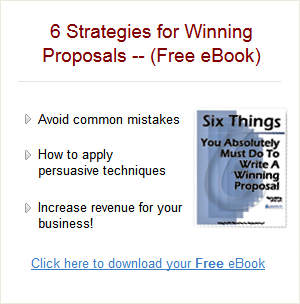Change the Way You Think About Proposals
What’s your impression of how the evaluation process goes? Do you imagine that the evaluator reads proposal after proposal until he happens upon the one that makes him stand up and say, “Eureka! This is it!”
You know that isn’t how it goes. Yet, chances are you write your proposals as if you think that’s how it goes. Chances are you are writing your proposal to win. What you need to do is write your proposal so you can’t lose.
The evaluators need all the help they can get when scoring proposals. Knowing something about how they go about their jobs can help you help them.
Evaluation is a Process of Elimination
Evaluating a proposal is really a process of elimination, rather than a process of selection. That’s why when you write your proposal you should not focus on writing a proposal that will be selected. You should instead focus on writing a proposal that cannot be eliminated!
You need to write your proposal—every proposal—so that there is no possibility the evaluator can toss it into the reject pile. Here’s how you can do this:
- Address all the solicitation requirements, regardless of how insignificant or silly they may seem.
- Spell out the benefits of your approach so the clients cannot help but see them. Substantiate all your claims with facts.>
- Use simple, easy to understand language; avoid long-winded sentences and paragraphs.
- Give clients what they want, not what you think they should want.
- Don’t tell the clients how great you are; let your strengths and the benefits they bring speak for themselves.
- Know your competition; do what you can to offset their strengths and exploit their weaknesses.
- Acknowledge that the clients may consider you weak in some areas, then do what needs to be done to redress those weaknesses.>
- Give clients the ammunition they can use to defend their decisions to their management or to their clients.
Rules of Thumb
Here are some rules of thumb that should drive how you prepare proposals:
RULE OF THUMB #1: You must tailor each proposal to the specific project and the specific client.
RULE OF THUMB #2: Each proposal must be easy for the client to read and follow.
RULE OF THUMB #3: You must take a systematic approach to writing proposals in order to manage the process efficiently.
If you let these three principles be your guide, you can dramatically reduce the risk of having your proposal end up in the reject pile. And increase your chances of winning.
Email us at psai@psassociates.com

